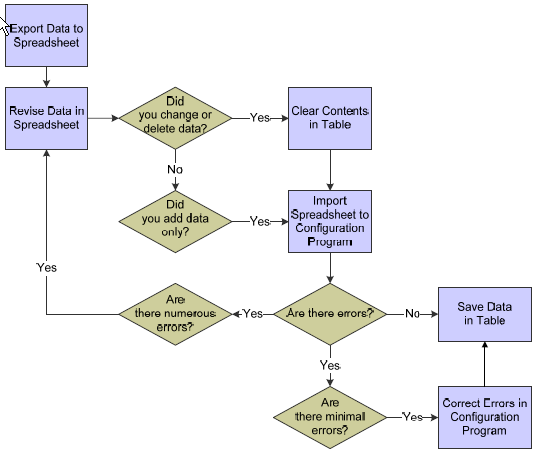Overview of the Export and Import Process for Business Data
The configuration programs enable you to export large amounts of business data at the same time from a table in the JD Edwards EnterpriseOne system to a Microsoft® Excel® spreadsheet. Using the spreadsheet, you can review the data and add, revise, and delete records as required. If you do not have existing business data as a starting point, you can use the configuration programs to export a blank template of a table and then add business data in the spreadsheet. Typically, when you export business data to a spreadsheet, you save it to a local environment or server.
The configuration programs also enable you to import data from a spreadsheet to the corresponding tables in the JD Edwards EnterpriseOne system. In combination, the export and import functionalities are integral to setting up your business data quickly and accurately during the initial setup phase of an implementation.
You can revise business data in a spreadsheet or configuration program. You can add business data records, as well as change and delete existing data and correct any data that the configuration program found in error. Most customers use the configuration programs for minor revisions and the spreadsheets for major revisions. The spreadsheet provides an easy format in which to manipulate large amounts of data.
Before you import the data from a spreadsheet to a configuration program, determine whether data already exists in the table for the environment. If data already exists in the table and you change or delete existing data in the spreadsheet, you must clear the contents of the table before you import the data to the configuration program. (See Overview of Clearing the Contents of a Table topic). If you intend to add data only during the import process, you do not have to clear the table.
When you import the data from a spreadsheet to a configuration program, the program displays the imported data, validates the data, and highlights any errors. If you have a minimal number of errors, correct them in the configuration program. Otherwise, correct the errors in the spreadsheet and then import the data back to the configuration program.
Continue the iterative process of exporting and importing data until you are satisfied with the data that exists in the JD Edwards EnterpriseOne table. You cannot save data to a table until all errors are corrected.
The following graphic shows the export and import process, from exporting data to a spreadsheet to importing the data and saving it in a table:

Before beginning the export and import process, business partners must determine which country- specific business data is closest in configuration to the country for which they are developing a configuration solution. To minimize the number of required revisions, use the business data for that country as the starting point for the configuration solution.